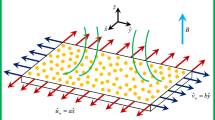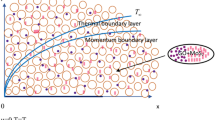Abstract
A mathematical model was developed and a mechanism was proposed for the formation of nanoscale structural-phase states by using a rail steel example in the process of long-term operation. It is believed that under intense plastic deformations, the material behaves as a viscous incompressible fluid. To consider sliding of a wheel relative to the rail, a two-layer fluid model was proposed in which the upper layer slides at some speed relative to the lower layer. In this case, the Kelvin–Helmholtz instability develops. For each layer, the Navier—Stoles equations, as well as kinematic and dynamic boundary conditions have been written. In the form of normal perturbation modes to the system obtained, a solution was carried out based on the assumption of the viscous-potential material flow. According to this approximation, it is considered that viscosity effects occur only at the layer interface. A dispersion equation was derived and analyzed using a graphical representation of the functions contained in the analytical solution. We have established the ranges of the material characteristics and parameters of the external impact (the velocity of the layer motion) at which two peaks are observed in the dependence of the perturbation’s growth rate on the wave number. The first (hydrodynamic) maximum is due to the motion of layers relative to each other; the second is associated with the effects of fluid viscosity. Approximate formulas have been obtained for the dependence of the perturbation’s growth rate on the wave number. The approximate formulas for the dependence of the perturbation’s growth rate on the wave number have been derived. The conditions necessary for realization of the only maximum have been found. The viscosity-induced maximum at slip velocities of the order of magnitude of 1 m/s may be observed in the nanoscale wavelength range. Assuming that the white layer in the rails occurring in the process of long-term operation is formed mainly due to the action of intense plastic deformations, we believe that the results obtained provide a more detailed understanding of the mechanism of white layer formation in the rails in the case of their long-term exploitation.




Similar content being viewed by others
REFERENCES
Gromov, V.E., Peregudov, O.A., Ivanov, Yu.F., Konovalov, S.V., and Yur’ev, A.A., Evolyutsiya strukturno-fazovykh sostoyanii metalla rel’sov pri dlitel’noi ekspluotatsii (Evolution of Structural-Phase States of Rail Metal during Long-Term Use), Novosibirsk: Sib. Otd., Ross. Akad. Nauk, 2017.
Ivanisenko, Yu. and Fecht, H.J., Microstructure modification in the surface layers of railway rails and wheels, Steel Tech., 2008, vol. 3, no. 1, pp. 19–23.
Ivanisenko, Yu., MacLaren, I., Sauvage, X., Valiev, R.Z., and Fecht, H.J., Shear-induced α → γ transformation in nanoscale Fe–C composite, Acta Mater., 2006, vol. 54, no. 6, pp. 1659–1669.
Ning, J.-L., Courtois-Manara, E., Kormanaeva, L., Ganeev, A.V., Valiev, R.Z., Kubel, C., and Ivanisenko, Yu., Tensile properties and work hardening behaviors of ultrafine grained carbon steel and pure iron processed by warm high pressure torsion, Mater. Sci. Eng., A, 2013, vol. 581, pp. 81–89.
Baumann, G., Fecht, H.J., and Liebelt, S., Formation of white-etching layers on rail treads, Wear, 1996, vol. 191, nos. 1–2, pp. 133–140.
Osterle Rooch, H., Pyzalla, A., and Wang, L.W., Investigation of white etching layers on rails by optical microscopy, electronmicroscopy, X-ray and synchrotron X-ray diffraction, Mater. Sci. Eng., A, 2001, vol. 303, pp. 150–157.
Wild, E., Wang, L., Hasse, B., Wroblewski, T., Goerigk, G., and Pyzalla, A., Microstructure alterations at the surface of a heavily corrugated rail with strong ripple formation, Wear, 2003, vol. 254, no. 9, pp. 876–883.
Zhang, H.W., Ohsaki, S., Mitao, S., Ohnuma, M., and Hono, K., Microstructural investigation of white etching layer on pearlite steel rail, Mater. Sci. Eng., A, 2006, vol. 421, pp. 191–199.
Takahashi, J., Kawakami, K., and Ueda, M., Atom probe tomography analysis of the white etching layer in a rail track surface, Acta Mater., 2010, vol. 58, no. 10, pp. 3602–3612.
Lojkowski, W., Djahanbakhsh, M., Burkle, G., Gierlotka, S., Zielinski, W., and Fecht, H.J., Nanostructure formation on the surface of railway tracks, Mater. Sci. Eng., A, 2001, vol. 303, nos. 1–2, pp. 197–208.
Ishida, M., Rolling contact fatigue (RCF) defects of rails in Japanese railways and its mitigation strategies, Electron. J. Struct. Eng., 2013, vol. 13, no. 1, pp. 67–74.
Steenbergen, M. and Dollevoet, R., On the mechanism of squat formation on train rails–Part I: Origination, Int. J. Fatigue, 2013, vol. 47, pp. 361–372.
Pal, S., Valente, C., Daniel, W., and Farjoo, M., Metallurgical and physical understanding of rail squat initiation and propagation, Wear, 2012, vols. 284–285, pp. 30–42.
Clayton, P., Tribological aspects of wheel-rail contact: a review of recent experimental research, Wear, 1996, vol. 191, pp. 170–183.
Wang, L., Pyzalla, A., Stadlbauer, W., and Werner, E.A., Microstructure features on rolling surfaces of railway rails subjected to heavy loading, Mater. Sci. Eng., A, 2003, vol. 359, nos. 1–2, pp. 31–43.
Glezer, A.M., On the nature of ultrahigh plastic (megaplastic) strain, Bull. Russ. Acad. Sci.: Phys., 2007, vol. 71, no. 12, pp. 1722–1730.
Mulyukov, R.R., Nazarov, A.A., and Imaev, R.M., Deformational methods of material nanostructuring: premises, history, state of the art, and prospects, Russ. Phys. J., 2008, vol. 51, no. 5, pp. 492–504.
Gromov, V.E., Yuriev, A.A., Peregudov, O.A., Konovalov, S.V., Ivanov, Y.F., Glezer, A.M., and Semin, A.P., Physical nature of surface structure degradation in long term operated rails, AIP Conf. Proc., 2017, vol. 1909, art. ID 020066.
Gromov, V.E., Yuriev, A.A., Ivanov, Yu.F., Glezer, A.M., Konovalov, S.V., Semin, A.P., and Sundeev, R.V., Defect substructure change in 100-m differentially hardened rails in long-term operation, Mater. Lett., 2017, vol. 209, pp. 224–227.
Yur’ev, A.A., Gromov, V.E., Morozov, K.V., and Peregudov, O.A., Long-term operation surface changes in differentially quenched 100-m rails, Steel Transl., 2017, vol. 47, no. 10, pp. 658–661.
Zerbst, U., Schodel, M., and Heyder, R., Damage tolerance investigation on rails, Eng. Fract. Mech, 2009, vol. 76, no. 17, pp. 2637–2653.
Zerbst, U., Lunden, R., Edel, K.-O., and Smith, R.A., Introduction to the damage tolerance behavior on railway rails—A review, Eng. Fract. Mech, 2009, vol. 76, no. 17, pp. 2563–2601.
Rubtsov, V.E., Tarasov, S.Yu., and Kolubaev, A.V., One-dimensional model of inhomogeneous shear in sliding, Phys. Mesomech., 2012, vol. 15, nos. 5–6, pp. 337–341.
Tarasov, S.Yu., Rubtsov, V.E., Kolubaev, A.V and Gorbatenko, V.V., Analysis of microscopic deformation fields during sliding friction, Izv. Vyssh. Uchebn. Zaved., Fiz., 2013, vol. 56, no. 7-2, pp. 350–355.
Rubtsov, V.E., Tarasov, S.Yu., and Kolubaev, A.V., Heterogeneity of deformation and shear instability of the material during friction, Izv. Vyssh. Uchebn. Zaved., Fiz., 2011, no. 11-3, pp. 215–220.
Sarychev, V.D., Vashchuk, E.S., Budovskikh, E.A., and Gromov, V.E., Nanosized structure formation in metals under the action of pulsed electric-explosion-induced plasma jets, Tech. Phys. Lett., 2010, vol. 36, no. 7, pp. 656–659.
Granovskii, A.Yu., Sarychev, V.D., and Gromov, V.E., Model of formation of inner nanolayers in shear flows of material, Techn. Phys., 2013, vol. 58, no. 10, pp. 1544–1547.
Sarychev, V.D., Nevskii, S.A., and Gromov, V.E., Model of the formation of nanostructures in rail steel under intensive plastic deformation, Deform. Razrushenie Mater., 2016, no. 6, pp. 25–29.
Sarychev, V.D., Nevskii, S.A., Sarycheva, E.V., Konovalov, S.V., and Gromov, V.E., Viscous flow analysis of the Kelvin–Helmholtz instability for short waves, AIP Conf. Proc., 2016, vol. 1783, no. 1, art. ID 020198.
Funada, T. and Joseph, D.D., Viscous potential flow analysis of Kelvin–Helmholtz instability in a channel, J. Fluid Mech., 2001, vol. 445, pp. 263–283.
Li, X. and Tankin, R.S., On the temporal instability of a two-dimensional viscous liquid sheet, J. Fluid Mech., 1991, vol. 226, pp. 425–443.
Dasgupta, D., Nath, S., and Bhanja, D., A study on dual role of viscosity on the stability of a viscous planar liquid sheet surrounded by inviscid gas streams of equal velocities, and prediction of resulting droplet distribution using maximum entropy formulation, Phys. Fluids, 2019, vol. 31, no. 7, art. ID 74103.
Shiryaeva, S.O., Grigor’ev, A.I., and Sukhanov, S.A., Kelvin–Helmholtz instability on the charged surface of a liquid with finite thickness on a hard bottom, Surf. Eng. Appl. Electrochem., 2013, vol. 49, no. 6, pp. 462–467.
Funding
This work was supported by the Russian Foundation for Basic Research, project no. 19-32-60001 Perspektiva.
Author information
Authors and Affiliations
Corresponding authors
Additional information
Translated by E. Smirnova
About this article
Cite this article
Sarychev, V.D., Nevskii, S.A., Kormyshev, V.E. et al. Model of Nanostructural Layer Formation during Long-Term Operation of Rails. Steel Transl. 50, 665–671 (2020). https://doi.org/10.3103/S0967091220100083
Received:
Revised:
Accepted:
Published:
Issue Date:
DOI: https://doi.org/10.3103/S0967091220100083




